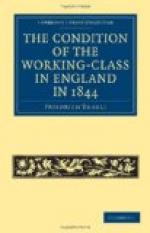It often happens that a whole Irish family is crowded into one bed; often a heap of filthy straw or quilts of old sacking cover all in an indiscriminate heap, where all alike are degraded by want, stolidity, and wretchedness. Often the inspectors found, in a single house, two families in two rooms. All slept in one, and used the other as a kitchen and dining-room in common. Often more than one family lived in a single damp cellar, in whose pestilent atmosphere twelve to sixteen persons were crowded together. To these and other sources of disease must be added that pigs were kept, and other disgusting things of the most revolting kind were found.
We must add that many families, who had but one room for themselves, receive boarders and lodgers in it, that such lodgers of both sexes by no means rarely sleep in the same bed with the married couple; and that the single case of a man and his wife and his adult sister-in-law sleeping in one bed was found, according to the “Report concerning the sanitary condition of the working-class,” six times repeated in Manchester. Common lodging-houses, too, are very numerous; Dr. Kay gives their number in 1831 at 267 in Manchester proper, and they must have increased greatly since then. Each of these receives from twenty to thirty guests, so that they shelter all told, nightly, from five to seven thousand human beings. The character of the houses and their guests is the same as in other cities. Five to seven beds in each room lie on the floor—without bedsteads, and on these sleep, mixed indiscriminately, as many persons as apply. What physical and moral atmosphere reigns in these holes I need not state. Each of these houses is a focus of crime, the scene of deeds against which human nature revolts, which would perhaps never have been executed but for this forced centralisation of vice. {65} Gaskell gives the number of persons living in cellars in Manchester proper as 20,000. The Weekly Dispatch gives the number, “according




